James Rugg & Brian Muruca: Grinding with SBC in a Blunt Manner
Posted: Tuesday, March 9, 2004
By: Darren Schroeder
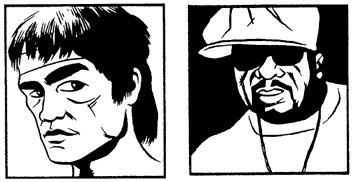
The blurb said: Jesse Sanchez, a.k.a. Street Angel, a homeless, malnourished, skateboarding, bad @$$, 13 year-old orphan battles the evils of the underworld, the inner city public school system, ninjas, hunger, alien invasions, frostbite, corrupt city government, poverty, and geology. It's an unflinching look at life on the mean streets, superheroes with social consciousness hitherto unseen in comic books. What the hype forgets to mention is that the artwork is delicious, and the writing shows a great gift for the absurd. I got all enthusiastic about this book and beat another SBC staff member to a pulp so I could win the chance ask the creators a few questions....
Darren Schroeder: What is your full name?
JR: James Rugg.
BM: Brian Maruca
DS: Age?
JR: 26.
BM: Just turned 31 in December.
DS: Do you do much skateboarding?
JR: No. The last time I tried skateboarding I fell really, really hard on my hip. The accident left a large purple and yellow bruise and I could barely walk for a week.
BM: I don't skateboard (because I'm a bit of a sissy).
DS: What was the first comic you published yourself and how did that come about?
JR: I did a comic book series called Outfitters a few years ago. After I graduated from college I wanted to make comics. The easiest way to do that was to make my own book. A friend of mine from college, Jasen Lex, was in a similar position so he did a book called Gypsy Lounge and I did Outfitters and we'd meet and look at each other's work and give feedback. When we finished the books, we started going to shows. it's been quite a learning experience.
DS: What sort of stories were these?
JR: Outfitters was autobiographical. It chronicled a time in my life that coincided with a summer job I had as a whitewater rafting outfitter. I would call the series a comedy. It had some more dramatic moments, but overall it was a comedy. One was set in the future and it was a reunion of the main characters. So I guess that one wasn't autobio exactly. The problem is, they are really poorly done, especially issue one.
DS: Did you alter much to make your character more likeable?
JR: I tried not to. I'm sure I altered the character to some degree, but not necessarily to make him more likeable. In some cases I would exaggerate a trait in order to more quickly establish the character. And I didn't want likeable characters because I think that's often an unintentional quality in autobio comics. I wanted the characters to come across as more realistic in that they aren't necessarily likeable just because they are the main characters.
DS:Who do you see as the target audience for your work?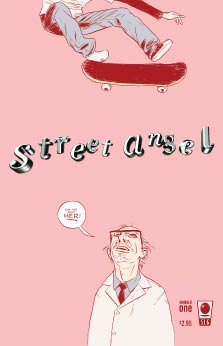 JR: I don't know. Girls maybe?
JR: I don't know. Girls maybe?
I think anyone who has ever liked superheroes will find something entertaining in the book. My favorite cartoonists are Dan Clowes, Chester Brown, Mignola, Ware, Charles Burns, Gary Panter, Crumb, Kirby, Eddie Campbell, the Hernandez bros. but when I started reading comics, I only read superhero books. Hopefully Street Angel will appeal to other readers with a comic book-reading background similar to my own. But I also want Street Angel to work well with traditional superhero fans. it's supposed to be a good superhero book not a parody or spoof or homage.
BM: I see the target audience as anyone with $3.00 to burn. Excluding my dad, he hates this crap.
DS: How do you two work together on the Street Angel?
JR: it's not easy. We brainstorm ideas first. Then argue a lot. Once we have a rough plot in mind, we translate that to paper and revise like crazy until we're left with a script that we both like. We take turns working on the script until we think it's okay, then we go through it together word by word and make more revisions. When the script is done, I draw it.
DS: Does Brian have any input into the final artwork?
JR: Yes. We discuss the storytelling extensively as the script undergoes revision. If I find myself stuck on a particular problem when I'm drawing the book or if I'm facing a choice and I'm unclear which solution works the best, I consult Brian. We go over the pages when they are done, which has in some cases led to redrawing details, panels, and even entire pages. With covers, he offers ideas and suggestions. I think for the first 2 I did a number of different roughs and we went over those together.
DS: What makes for a bad comic?
JR: There are so many horrible comics out there, where to begin? Poor writing and derivative art sucks. Bad stories are a waste. Over exposed, washed up, tired characters. Under developed characters. Books without a sense of humor. I hate probably 90% of the coloring in current comics so bad that I can't even read them.
BM: That's so hard to say. I loved Marvel books from the late 80's. Then, a few years ago, I tried re-reading some of them and I thought that they were terrible. I haven't really thought too much about why that happened (probably I grew up, didn't need the escapism factor any more).
DS: What does the term small press mean to you?
JR: To me, small press means self-made or in some cases self-published comics and mini-comics - more of an endeavor of love than a money making scheme.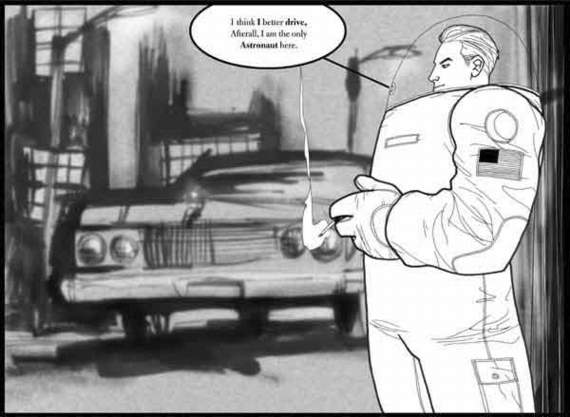
DS: I take it that you did graphic design at college, were comic covered in any of your courses?
JR: I earned a BFA in graphic design with a minor in painting. Comics weren't covered in any of the classes and I did not spend a great deal of time working on comics in college. I probably could have focused on comics in some advanced studio classes where we did more independent work but I didn't. I'm not sure why. There were other students in the art department that were into comics, but we never did anything except talk about comics. I regret that I didn't spend more time working on comics in college. That's such a good environment to solicit feedback from both comic readers and people outside of the comics field.
DS: How do you two support your comic making habit?
JR: At first I saved some money and used that to pay for printing. Then when I started making mini comics my overheard was low; it wasn't really a problem to pay for fifty or one hundred photocopied books a few times a year. The harder part of the equation right now is finding the time necessary to support the comic making. I suppose if I quit my job, the hard part would be financial support. it's a Catch-22 and the main reason the book is quarterly. I would love to do it bimonthly, but that's just not possible at the moment.
DS: What sort of jobs do you two have - are they graphic design related?
JR: I'm a graphic designer in a tiny marketing department in an engineering company.
BM: Tech Writer in the same department of the same company. We're 2/5ths of the marketing squad. We wouldn't field a very good basketball team, in case someone was thinking of challenging us.
DS: Did you have any reason in mind for choosing a female lead character?
JR: The female lead stems the sexual fetishes that abound in the superhero genre. I'm not exactly sure what the fetishes represent; they seem to point towards misogyny, homosexuality, and possibly pedophilia. I wanted Street Angel's character to contrast with the standard, dominant male archetype and to draw attention to these strange conventions. I thought the most effective way to do that was through the apparently subtle contradiction of them in her character design. Hopefully they are conspicuous in their absence.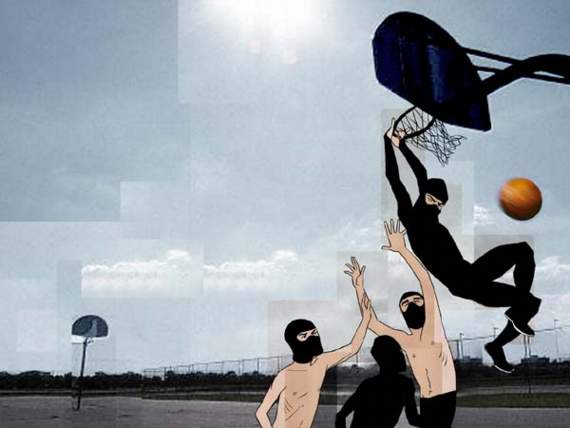
DS: Why do Ninjas have such a bad reputation these days?
JR: I thought they had a good reputation. One reason we use them is because they are iconic. Their inherent qualities (classic, deadly assassins) help to define Street Angel's character and the toughness of her setting while simultaneously offering a certain generic, humorous side. Both qualities benefit the book without requiring Brian and I to invest time developing them. I also think they look good graphically.
DS: What's the mechanics of the relationship between you two and SLG; do they actively edit/direct your work, do you get any input into marketing?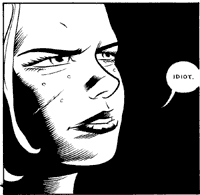 JR: We send them the finished art and their editor-in-chief proofs it and sends us the corrections. So far her changes have been limited to grammatical problems and clarity-related dialogue changes. She said we could send her the script for proof purposes but we change stuff during the drawing stage and even after that. So unless directed otherwise, I guess we'll continue to send her the finished pages and proof from that.
JR: We send them the finished art and their editor-in-chief proofs it and sends us the corrections. So far her changes have been limited to grammatical problems and clarity-related dialogue changes. She said we could send her the script for proof purposes but we change stuff during the drawing stage and even after that. So unless directed otherwise, I guess we'll continue to send her the finished pages and proof from that.
No one at Slave Labor has suggested any content/story changes yet. Dan and I went over the mini-comic and agreed on a couple of storytelling problems that I tried to fix when I redrew it. He also wanted 2 changes that you could classify as marketing related. First, the old logo changed to something more readable and second, the size of the book was changed from the mini-comic size (8 1/2 x 7) to a standard comic-book size.
Their sales director, Deb Moskyok, and I have corresponded a number of times. She has been very receptive to suggestions we made and questions we've had regarding marketing materials.
So far, it's been a pretty ideal relationship. Brian and I have had plenty of freedom creatively and Slave Labor handles the publishing side of things. They've been very good about keeping in touch with us throughout the process.
DS: How long had you done the title as a mini?
JR: Brian and I had made 1 issue of a mini-comic and written a handful of additional stories that featured the character. I sent Dan the mini comic shortly after we finished it, and he got in touch with me before I had begun drawing a second issue.
DS: What did you find to be the pros and cons of the mini format?
JR: The biggest pro I found with the mini format (as opposed to offset printing) was that I could inexpensively produce a relatively high quality book in low quantities (mini-comic makers should check out Jordan Crane's Repro guide for tips on reproducing line art). I like the hands on aesthetic of them and the DIY attitude that goes with them. I don't think the format prevents mini-comics from competing with cheaply printed standard comics.
The biggest con I can think of with minis is that assembling them sucks. Also, if you end up doing a few hundred books, the cost, per book, doesn't come down much. It's a great format for ten issues, or one hundred issues, but the big pro of low cost starts to be less apparent as the print run climbs.
I'd like to mention lower circulation, but I can't decide whether It's a pro or con. The pro side is that I sold most of my minis at shows, particularly indie/small press shows. I think the consumers at these shows are more open minded and receptive to alternative comics. So the readership is smaller but perhaps more interested in your work? The con side is that many stores do not stock minis and it can be difficult to reach a wide audience.
DS: From the outside it seems like a big break to move from small press to being published by a company. I don't expect you to show me a bank statement, but Is getting Street Angel published by Slave labour a financially rewarding enterprise - are we talking pocket money, new TV or world trip?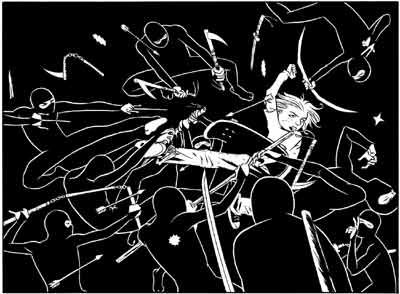 JR: We could make some money depending on how well the book sells. Initially it looks like we'll only make a modest amount and most of that goes back into the book (paper, brushes, computer hardware, web server space, show expenses, promo materials). But I knew that it is difficult to make money in this industry right now. And even if each issue was fairly profitable, we're only publishing quarterly. I came into this with realistic expectations, and I'm happy with where we are at this time. I think it's important that cartoonists examine the financial reality and difficulties of this industry before they over commit to it. I think it's possible to be financially successful in the small press/self-publishing area. But it requires a super high level of self-discipline, detailed planning, talent, and a little luck. Some of the requirements for financial success (and I'm defining that as profitable enough to make a decent living) may include commercial considerations and sometimes compromises.
JR: We could make some money depending on how well the book sells. Initially it looks like we'll only make a modest amount and most of that goes back into the book (paper, brushes, computer hardware, web server space, show expenses, promo materials). But I knew that it is difficult to make money in this industry right now. And even if each issue was fairly profitable, we're only publishing quarterly. I came into this with realistic expectations, and I'm happy with where we are at this time. I think it's important that cartoonists examine the financial reality and difficulties of this industry before they over commit to it. I think it's possible to be financially successful in the small press/self-publishing area. But it requires a super high level of self-discipline, detailed planning, talent, and a little luck. Some of the requirements for financial success (and I'm defining that as profitable enough to make a decent living) may include commercial considerations and sometimes compromises.
My main reason for working with Slave Labor was to increase my exposure and to learn more about the industry and comics production, not to make a living. I did mini-comics for a couple years because they allowed me to grow as a cartoonist, to take inexpensive risks, and to benefit from reader feedback. Now I feel that my work has reached a point where I want to show it to a larger audience. I feel I have a long, long way to go as a cartoonist, but I think it's vital to have reader interaction along the way. After all, I do want readers. And waiting until I feel my work is perfect is impossible. I will never think my work is perfect. As painful as many artists find their early work, it is necessary to produce that work in order to get to the better work that comes later. It doesn't matter how good an artist or writer is, once that work is seen through someone else's eyes it changes and that is why I feel it is important to show the work as I develop.
To answer your question, the big break (and I agree that it is one) for me is in reaching a wider readership. My minis had print runs in the low 100s; Street Angel is over 1000. To me, that progression is perfect. I hope to produce comics my whole life. Someday hopefully it will be a full-time occupation. But for now, I'm just trying to improve and I expect this opportunity with Slave Labor will help me a lot in that regard.
BM: To actually answer your question
probably: pocket money
maybe (but unlikely): a new tv
pretty hard to fathom: a world trip.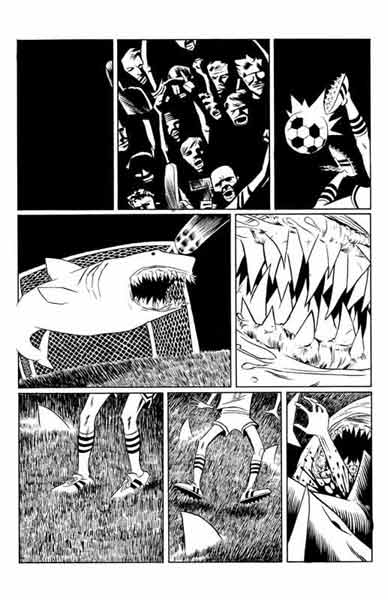 DS: How do go about laying out a page of artwork?
DS: How do go about laying out a page of artwork?
JR: I usually thumbnail each page. Sometimes I do one thumbnail and sometimes I do 20. My thumbnails are fairly big, because I like to try to work out as much detail about the composition as possible. This might be changing though; because I'm unhappy with my compositions and want to concentrate on their improvement. One idea to improve them is to do smaller thumbnails that show the black and white placements but not a lot of the details. When I'm happy with the thumbnail I switch to the page.
I use paper that I buy in 14 x 17 inch pads (plate or smooth finish). I start by cutting 3 inches off the width. I tape a piece to my drawing table and rule the margins and panels. I lightly draw roughs of everything. With the rough drawings in place, I add the lettering in pencil. I untape the page and ink the lettering (C6 nib), word balloons, and panel boarders (rapidograph). I tighten the penciling to various degrees depending on how much information I think I need to ink the page. Then I ink it. I have no pattern for inking. Sometimes I start with a brush (usually a cheap nylon brush); sometimes I start with a pen (I've been using a Hunt 102 on Street Angel), it depends on my mood I suppose. When I'm done, I erase the page and scan it.
DS: Is there a piece of drawing equipment you'd cheat and steal to own?
JR: No. I do most of my drawing the old fashioned way with pencil, pens, and brushes - nothing fancy and nothing too expensive. I'd like a scanner that can handle 11 x 17 paper, but I'm not even sure where I can steal one of those. I've only seen them for sale online.
DS: In issue one I really liked the gag with the megaphone - where did that spring from?
JR: I can't remember. It's been over a year since that was written
we try to stay aware of Jesse's immaturity and that's a good example of it. But the particular influence escapes me.
BM: The one thing in that scene that no one's caught is the mayor's candy dish - It's clearly full in one panel, then, later, empty. She stole all of the candy.
DS: If you needed someone else to illustrate an issue, who would you ask and why?
JR: Farel Dalrymple, Jasen Lex, or David Choe. They've all done excellent comics with urban settings and young characters. Plus I'm friends with Farel and Lex. Gary Panter would be really great, but I could never ask him.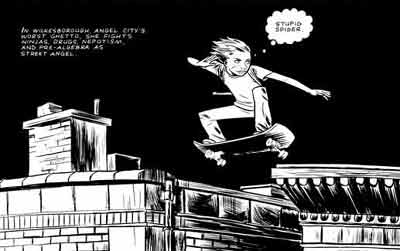
DS: What would scare Street Angel into inactivity?
JR: I have no idea.
DS: Can readers expect to see you two at any conventions?
JR: I'll be at SPACE in Columbus, OH, Pittsburgh Comicon, Mocca, and SPX this year.
BM: I'll be at Pittsburgh, I really don't know about the others.
DS: Will we learn anything of Street Angel's past, or shall she remain the skater with no past?
JR: I doubt we'll ever get into a serious origin. We have a story that's set before the events of issue 1, and that may be done for a Street Angel collection at some point. It's like the craziest issue 0 you'll ever read. I'm not usually a fan of origin stories.
Eventually, we may divulge how the Bald Eagle lost his limbs. We have some ideas for that. But we'll see. We'd like to reveal it in short back up features in Street Angel. I just don't have the time to draw it right now.
BM: I'm a little more ambivalent towards origins than Jim ... but we don't really have one for her. It didn't seem necessary. Does it really matter how she can do what she does? Being bitten by a radioactive spider shouldn't really make spider-like abilities any more plausible. It's all about the suspension of disbelief - like before reading Spider-man's origin, I was completely unwilling to accept his abilities. I don't know. Anyone who argues about believability in comics should probably take a step back and think about what they're arguing.
SD: A quote on your sitementions that you were once homeless Jim - Is that where Street Angel's social activist side comes from?
JR: I was never homeless. That quote is from a review of issue one and it's based on the text on the inside back cover. I thought it was funny that someone would cite this claim as evidence of the book's authenticity. Brian and I intentionally created a character, environment, and situation that we had zero experience with because we wanted to lampoon the whole authenticity trend in pop culture. They say write what you know, we decided to write only what we don't know. Chances are if you read something in Street Angel, neither Brian nor I have ever experienced it.
BM: Jim got an anonymous email from someone (a coward if there ever was one) calling him a jackass for claiming he was homeless. That guy saw right through us.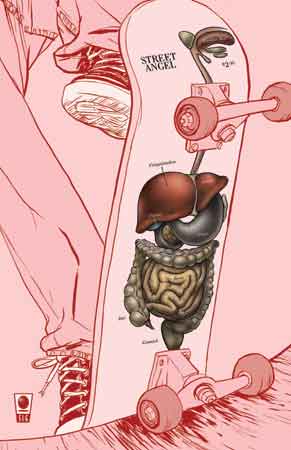 DS: Describe or draw a picture of the view out your front door.
DS: Describe or draw a picture of the view out your front door.
JR: Big houses from the 1920s that follow two or three similar floor plans and designs. Squirrels. People walking dogs. SUVs everywhere. A few trees. A yellow brick road. Lots of kids. Tiny patches of grass. Sidewalks. Every once and a while I see a small gray cat.
BM: There's often a woman leaning out of her second story window across the street. She only wears nightgowns (from what I can tell) around the house. The impression that you tend to get is that you're being mooned, except instead of her ass It's her ass-like cleavage. She's not good people.
DS: One for Brian - Are comic writers undervalued, and if so, why do you think that is?
BM: I really can't say, I don't know any other comic writers. The writing tends to go hand-in-hand with the drawing, though. I imagine that the guy who draws the comic will be perceived as the guy who adds the most value to the book. That's kind of how I view it. People will probably give a poorly written comic a longer look if the drawing is spectacular than a well-written, poorly drawn book.
DS: One for Jim - Are comic writers overvalued, and if so, why do you think that is?
JR: No. I think writing is just as important in narrative-based comics as the art. It's very difficult to tell where one ends and the other begins. Writers are not overvalued, but like any field, most of them are lousy.
DS: Thanks to Brian and Jim for taking the time to answer my questions. Issue #1 should be in your local comic shop this week. Track it down.
You can contact the guys a variety of ways:
Jim: Jimrugg@hotmail.com - Brian: bm2i@yahoo.com
P.O. Box 4517, Pittsburgh, PA 15205, USA.
http://www.streetangelcomics.com
To purchase comics, contact Jim or visit Slave Labor's web store at http://www.slavelabor.com
What I really thought of issue 1, plus there's a preview online http://www.streetangelcomics.com/saonepre.htm if you need more convincing.
If you have a comment or question about Small Press then feel free to contact me